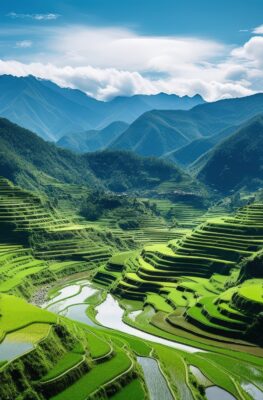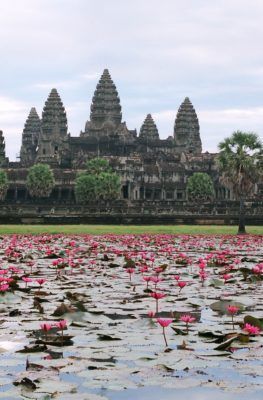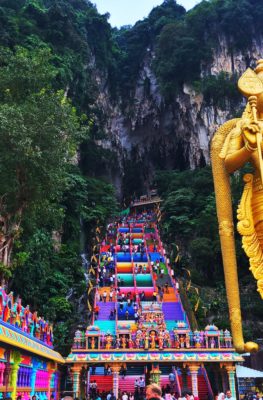Published on July 10, 2015

Kampong Glam, Singapore. Image © Mike Aquino.
When tourists experience the delicious food and the gentle culture of Southeast Asia’s cities, they unconsciously plug into Southeast Asia’s history.
The region’s cuisine and culture are, after all, the results of thousands of years of cultures growing and intermingling across borders, absorbing outside influences and remaking them into something totally unique to Southeast Asia.
At the risk of oversimplifying Southeast Asia’s diverse history, travelers can discern three waves of outside influences that have become part of the region’s culture. The first wave may have begun around 200 BCE, when Hinduism (and later Buddhism) took root in Southeast Asia, thanks to the influence of merchants, gurus and visiting dignitaries from the Indian subcontinent. This wave took hold most strongly in Thailand, Cambodia, Laos, and Myanmar.
Starting in the 13th century, a second wave of missionaries from India brought Islam to the region. The new religion flourished particularly in Sumatra, Java and the Malay Peninsula. The third wave came in the form of Christian missionaries traveling alongside Western conquerors, who divided much of the region among themselves between the 16th century and the 20th.
Wherever these new ideas went, they tended to cross-pollinate with indigenous beliefs, rather than replace them outright.
For example, the city of Yogyakarta in Indonesia is thoroughly Islamic, but remains thoroughly Javanese nonetheless. Visit the Kraton – or the Sultan of Jogjakarta’s palace in the center of the city – and you’ll find how much of the Sultanate’s history, traditions and art continue to draw from both Hindu and traditional Javanese (“Kebatinan”) influences.
Venture further from Yogyakarta and you’ll go deeper into the city’s historical roots: the Mataram kingdoms (from which the Sultan claims descent) left traces of their existence, such as the towering spires of the Prambanan complex to the mysterious carved mandala known as Borobudur.

Borobudur, near Yogyakarta, Indonesia. Image © Mike Aquino.
Myanmar’s Bagan tells a different story: between 1044 to 1287 CE, the Buddhist Pagan Empire of upper Burma ruled their empire from this spot, constructing over 10,000 stupas, monasteries and temples to command the devotion of their subjects. Only about 2,000 of these remain standing, a testament to the ancient Buddhist belief that erecting a stupa would earn merit for the builder.
The best temple remains in Bagan contain abundant images of the Buddha, in varying sizes and levels of detail. You’ll want to spend more than three days in Bagan if you want to see all the important temples and stupas in all their glory.
Luang Prabang in Laos retains much of the character it developed over the centuries as the Kingdom of Laos’ cultural and political capital. Resisting invasions from its Khmer and Thai neighbors, the Kingdom of Laos eventually became part of the French colonial empire, which left its mark on Luang Prabang through low-key European influences in the local architecture and the overall relaxed charm of the town at present.
Buddhism still underpins the local culture, though, starting with the morning “tak bat” alms giving ritual by the monks, and even more so in the lavishly decorated temples in the vicinity – Vat Xieng Toung is a perfect example, and should not be missed.
The ancient trading city of Hoi An in Vietnam’s Quang Nam Province served as a meeting place for many of the region’s cultures. Chinese, Japanese, Portuguese and many other nationalities did business at Hoi An’s bustling port, until the river’s increasing siltation forced trade to move upriver to Da Nang.
Thankfully, as the attention of warring factions turned elsewhere during the 20th century’s interminable wars, Hoi An was spared: today, the city’s centuries-old assembly halls, pagodas, bridges and temples remain standing, a “living museum” to a time long gone by. In recognition of the town’s living history, UNESCO granted Hoi An World Cultural Heritage recognition in 1999.
Southeast Asia’s European influences can most strongly be felt in Singapore and the Malaysian cities of Malacca and Penang. All three are tied together by their common history as part of the British Straits Settlements.
You’ll find the heavy imprint of colonial history in their buildings and culture. George Town in Penang is full of Victorian-era architecture, now coexisting alongside museums, hawker centers and hip new cafes. Malacca’s old square, along with nearby Chinatown and Saint Paul’s Hill, retain buildings left over from successive Portuguese, Dutch and British rule. And Singapore’s heritage trails proudly display structures built by the British in the 19th and 20th centuries, lovingly maintained and repurposed by Singaporeans into the 20th century.

Cobbled street in Intramuros, Manila, Philippines. Image courtesy of the Philippines Department of Tourism, used with permission.
A different kind of European influence can be experienced in the Philippines city of Manila. Its walled city of Intramuros was a Spanish bastion for four centuries, having been raised over the ashes of a palisaded Malay fortress called Seludong that was burned down by Spanish conquistadores in 1571.
The “distinguished and ever loyal city” built by the Spanish still stands, unbowed even after a rain of bombs flattened Manila in the twilight of the Second World War. The Manila Cathedral, Palacio del Governador and the Ayuntamiento flank the Plaza Roma, each building symbolizing separate centers of power during Spanish rule. Fort Santiago can be found less than ten minutes’ walk west – it was a forbidding prison during the rule of the Spanish and Japanese, but now commemorates the Filipino hero Jose Rizal, who spent his last night in a Fort Santiago cell before being shot at the park that now bears his name.
As empires have come and gone and history made and unmade over millennia, Southeast Asia’s cultures have taken them all in – and made them their own.






